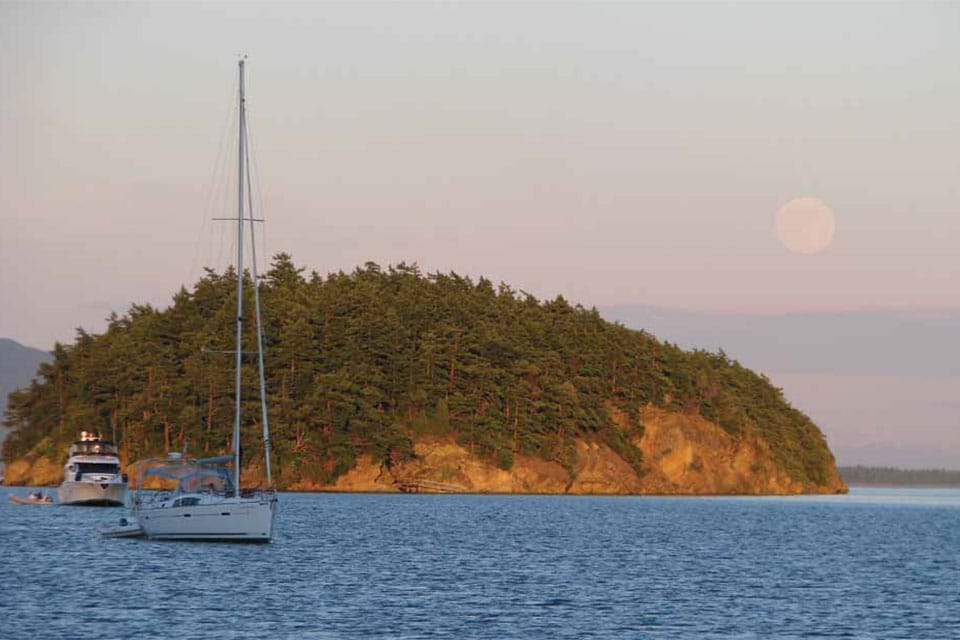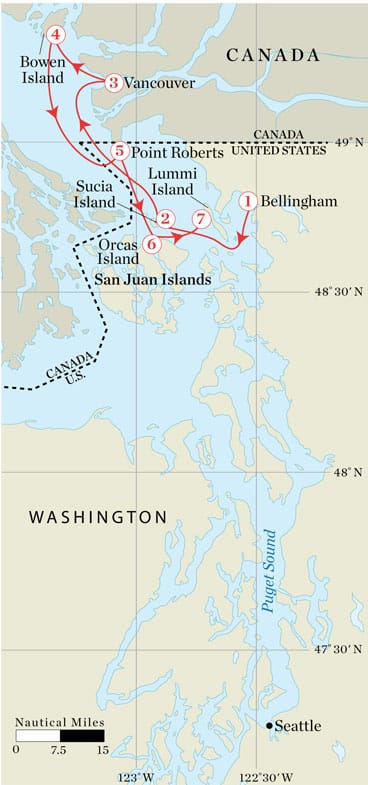
Pacific Northwest Sailing
What a perfect coincidence. It was June 22, the day of the Summer Sailstice, the worldwide celebration of sail on the solstice. Aboard Raven, our Catalina 42, not only had my mates and I remembered to bring along the event’s burgee, we actually remembered to raise it too, letting it fly during a light-air sail from the base of San Juan Sailing in Bellingham, Washington, to Sucia Island, one of the San Juans group.
With a couple of kayaks lashed to the deck, and daylight that lasted well past 9 p.m., our crew and the crews of eight other boats in the flotilla organized by the American Sailing Association were bursting with anticipation. Not only were all of us thrilled to be out sailing, with the promise of all the attendant rewarding activities like hiking and making new friends while exploring new places, we were bursting with anticipation of another phenomenon that had grabbed the headlines: the Super Moon, so called for the enhanced appearance of the orb due to its position at perigee.
And was it ever. Later, snug on moorings at Echo Bay, after paddling, dinghy racing — yes, dinghy racing — cocktail hour and dinner, we took in with awe the giant white light of the moon. What a calming end note to a jam-packed day. And what a great way to start what would culminate in a terrific adventure for our group of 35 new and veteran sailors.
Our route for the week, as scoped out by Roger Philips, flotilla leader and two-time ASA instructor of the year, led our mixed fleet of monohulls and multihulls north from Bellingham through the San Juans to the Pacific coast of British
Columbia, Canada, and included stops in the cosmopolitan city of Vancouver, as well as its lush, rural opposite, nearby Bowen Island, before heading back south. Clearing in with Canadian and U.S. customs officials was, of course, part of the itinerary.
While Roger, who has partnered with San Juan Sailing for six years on this trip, relies on the resources of the base, its fleet and staff, he’s the hands-on guide, the one who oversees a pile of helpful details, from reminding sailors to bring along their passports to putting crews of varying skill levels together.
When I was introduced to him before our short flight to Bellingham from Seattle, I had a chance to gain some insight into the ASA flotilla experience.
Flotillas, Roger said, were a way to take the experience of formal ASA curriculum instruction to the next level. “It’s primarily a fun thing and an adventure for people,” he said. “You learn, but then what? Going with a group is more fun. It’s nice.”
Without realizing it, my flotilla leader had just issued me an order.
On the spot, I decided that wherever we made landfall, I’d invite myself over to the other boats and ask my fellows in this fun cruise in company who they were, how they were doing, and why they’d come along.
Kim Reinbold, part of the crew who’d chartered One World, a Lagoon 400, happily stood out as a perfect example of the ambitious learner.
“Any day on a boat is a good day,” said the biologist, who works for the Environmental Protection Agency in Ohio. “Being on the water has been a passion all my life. I grew up close to Lake Erie and my dad had Thistles. At a Discover Sailing event, I sailed on a 36-foot Hunter, and it was the first time I was on a bigger boat under sail. I was hooked! Karl, my husband, and I can retire in eight years, and we want to sell it all and move aboard. This is a test to see if I can handle it and like it. There are only so many times you can do this, living in Ohio. We have a huge learning curve. We’re looking forward to more learning. The dream is still alive!”
Kim’s colleague Ken Mottler isn’t a sailor, but was invited to join the rest of the One World crew. “It’s a little bit like taking a sip from a fire hose,” he said. “The learning is so much fun.”

For many, the Pacific Northwest destination was uncharted territory. Globe girdlers Rick Waters and his wife, Sarah Beran, aboard Liberty, a Hunter 41, had come home for three weeks from the Middle East, and were eager to reunite with friends and family and catch a break from 120-degree heat.
While the couple had ASA certification and had chartered in the Caribbean and Thailand, they’d never sailed in the Pacific Northwest, where Sarah is from. “We weren’t that comfortable with cold-water sailing, tides and currents,” Rick said. “And we also wanted to be around experienced sailors so we could learn more from them. This is great. The briefing was thorough. We like the radio calls and the chart briefings. We like both sailing and exploring, so this is a nice mix. And it’s nice we can do things on our own.”
While most boats carried mates who knew each other, a few carried crew who didn’t. “We talked by Skype video to each other, and in the spirit of helping people go sailing, I decided to do it,” John Kvederis, the captain of Salus, a Jeanneau 40, told me before we set out.
As days went by, I was eager to hear how things were progressing aboard Salus. I visited the crew while they were lounging in the cockpit on a rainy morning, the fleet having docked at Fisherman’s Wharf Marina on Granville Island, in Vancouver, the previous night.
“I’m from Seattle,” said James Smith, a young man with a long beard who sported bright yellow foul-weather gear from head to toe. “I just finished college, and I’m headed to California to open a bakery and restaurant. This was the last part of what I wanted to see and do in the Pacific Northwest. I was looking for more time on the water. As for sailing with strangers, I wouldn’t have it any other way. I really enjoy these guys.”
The cruising ground straddling the 49th parallel that separates Canada and the United States in the temperate Pacific Northwest region offers up a range of challenges: little wind to sudden and intense wind: tidal fluctuations from 2 to 12 feet; currents and countercurrents of 2 to 6 knots.
There’s more, the kingpins at San Juan Sailing, owner Roger Van Dyken and manager Rick Sale, had advised. Throughout the week, we kept in mind their handy boat-handling tips and their warnings to stay on the alert for shipping lanes, rocks, fog, logs, and crab and shrimp pots. We avoided distractions, refrained from complacency, and made our own decisions.
We were so good at doing what we were told that I started thinking we were behaving more like a classroom of shy, attentive schoolchildren than a salt-stained crew of rum-swilling swashbucklers, but so be it. While scanning the majestic skyline of dark emerald forest and mountain, we stayed on guard for ships, logs, rocks, frothy tide lines full of bull kelp, fog and fluky winds. Reward came in numerous sightings of seals and Dall’s porpoises, puffins, kingfishers and bald eagles, and, while kayaking, purple sea stars and plump anemones closer to shore.
When it rained, I was grateful the deluges washed a touch of our wholesome tendencies away. “Let’s meet at a bar for happy hour,” suggested Judy Croyle from Cat’s Paw, a Gemini cat, while we were still in Vancouver. Word circulated, and hours later, damp crews from several boats bonded at Bridges, a local restaurant, swapping sea stories and learning from each other how sailing had drawn them to this point and place in their lives.
The tale of how former motorcyclist Erin Laird, crewmate aboard the Catalina 42 Hula Kai, came to the flotilla is poignant and hinted at new beginnings. “I can’t ride anymore,” she told me, “so I’m looking for something new.” Injured in a bad accident a couple of years back, Erin said she has recovered to the point that she can participate in a new activity, and she’s exploring sailing and its liveaboard lifestyle.
I’d accepted an invitation from flotilla leader Roger to take the short 10-mile hop from Vancouver to Bowen Island without realizing that Erin was part of the crew, so I was looking forward to getting to know her a little during our sail.
As we got under way, the wind filled in, blowing a decent 10-15 knots from the south. Roger directed his crew to fly wing and wing, with Erin, who’d been soaking up his instruction like a sponge, at the helm.
For a new sailor, off-the-wind sailing can be challenging, and staying in the right slot to keep the sails filled nerve-racking, but Erin stayed focused. “This is cool, really cool, but I have to concentrate,” she announced. “It’s hard.”
“It is hard, but you’re getting it,” Roger said, adding, “Hey, we’re sailing!”
“Finally!” Erin exclaimed.
“My job is done!” said Roger.
And with that Hula Kai and crew glided gracefully toward Bowen Island, ahead of the bulk of the fleet. Once all the boats were in and tied up at the docks, we struck out for Doc Morgan’s, where a spread awaited on the pub’s suddenly sun-drenched deck.
CW deputy editor Elaine Lembo writes about chartering. This article first appeared in the March 2014 issue of Cruising World.








